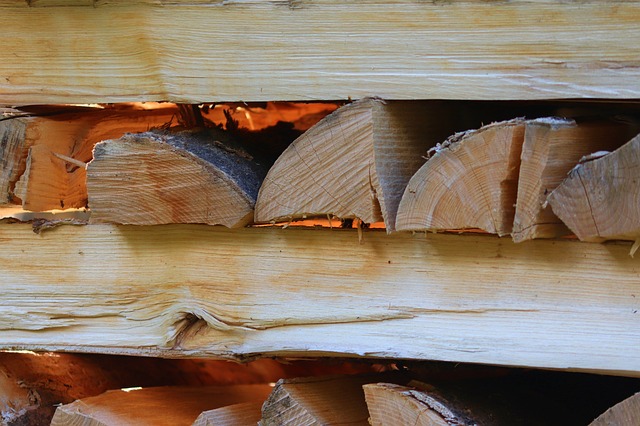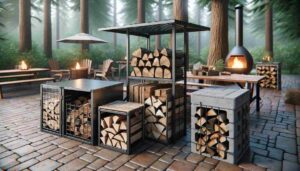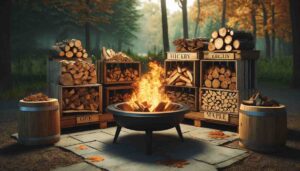When it comes to heating our homes or enjoying a cozy fire, the type of firewood you use plays a crucial role. Not all firewood is created equal, and different wood species have distinct characteristics that can affect their performance as fuel. That’s why it’s important to understand the qualities of different types of firewood, including poplar. If you’re wondering whether poplar is a good choice for your fireplace or wood stove, you’ve come to the right place.
Poplar can be used as firewood, but it has some limitations. It burns relatively quickly and produces less heat compared to hardwoods. However, if you need firewood that seasons quickly and is easy to handle, poplar can be a suitable option.
Poplar is a widely available and often overlooked option. Some people love it, while others have reservations. In this guide, I’ll explore the ins and outs of using poplar as firewood, its heating value, pros and cons, burning characteristics, and even alternative uses for poplar wood. By the end, you’ll have a comprehensive understanding of whether Poplar is the right firewood for you.
What is Poplar?
Poplar is a type of tree that belongs to the genus Populus, which is part of the larger family of Salicaceae. It is a deciduous tree, meaning it sheds its leaves annually. Poplar trees are known for their tall and straight trunks, and they can reach impressive heights, making them a common sight in many parts of the world.
Several species of poplar are commonly used for firewood, including the Eastern cottonwood (Populus deltoides), Lombardy poplar (Populus nigra ‘Italica’), and hybrid poplar (a crossbreed between different poplar species). Each species has its own unique characteristics and qualities as firewood, which we’ll explore further in this guide.
Poplar wood is relatively lightweight and has a fine, straight grain. It is generally soft compared to hardwoods like oak or maple, which means it’s easier to split and handle. Poplar wood is often light in color, ranging from pale yellow to whitish, with some species exhibiting greenish or gray tones. These properties make poplar wood versatile for various purposes, including firewood and woodworking projects.
Now that you have a basic understanding of what poplar is as a tree and its general characteristics, let’s delve deeper into the heating value of poplar firewood and whether it’s a good choice for keeping us warm and cozy.
Heating Value of Poplar Firewood
Heating value refers to the amount of heat energy produced by burning a specific type of firewood. It is measured in British Thermal Units (BTUs). Understanding the heating value is important because it helps us determine the efficiency and effectiveness of different firewood types in providing warmth and maintaining a fire.
Poplar wood generally has a lower heating value compared to dense hardwoods such as oak or hickory. On average, dry poplar firewood can produce around 15 to 20 million BTUs per cord. Keep in mind that the actual BTU value can vary depending on factors such as moisture content, tree species, and specific growing conditions.
In terms of heating value, poplar falls on the lower end of the spectrum compared to hardwoods like oak, maple, or ash. However, it can still provide a decent amount of heat when properly seasoned and used in combination with other firewood types.
It’s important to note that while poplar may have a lower heating value, there are other factors to consider when evaluating its performance as firewood. I’ll explore the pros and cons of using poplar as firewood in the next section to give you a more comprehensive understanding.
Pros and Cons of Using Poplar as Firewood
Pros:
- Quick seasoning and drying time: Poplar wood has a relatively low moisture content, which means it seasons and dries relatively quickly compared to hardwoods. This is beneficial because properly seasoned firewood burns more efficiently, produces less smoke, and provides better heat output.
- Ease of splitting and handling: Poplar is a softwood, making it easier to split and handle compared to dense hardwoods. If you’re chopping your own firewood, poplar can save you time and effort when it comes to splitting logs.
- Availability and affordability: Poplar is a widely available tree species, and its firewood is often more affordable compared to hardwoods. If you have easy access to poplar wood, it can be a cost-effective option for keeping your home warm during the colder months.
Cons:
- Lower heat output compared to hardwoods: While poplar can provide decent heat, it typically has a lower heat output compared to hardwoods like oak or maple. This means you may need to burn a larger quantity of poplar wood to achieve the same level of warmth.
- Faster burn rate and shorter burn times: Due to its lower density, poplar tends to burn relatively quickly. This can result in shorter burn times compared to denser firewood types. If you’re looking for long-lasting fires, poplar may not be the ideal choice.
- Less ideal for extremely cold weather conditions: Poplar’s lower heat output and faster burn rate make it less suitable for extremely cold weather conditions, where you may require more sustained and intense heat. In such cases, combining poplar with higher-density hardwoods can help extend burn times and maximize heat output.
Burning Characteristics and Tips
When it comes to burning poplar firewood, here are some key characteristics to keep in mind:
- Flame appearance and behavior: Poplar wood typically produces a relatively lively flame with moderate crackling. It can provide a warm and pleasant ambiance when used in fireplaces or wood stoves.
- Smoke and aroma produced: Poplar wood generally produces less smoke compared to other firewood types. This can be beneficial for those who prefer minimal smoke and less chance of buildup in the chimney. Additionally, poplar has a mild aroma when burned, which some people find enjoyable.
Tips for effectively burning poplar firewood:
- Properly seasoned and dried wood: Like any firewood, it’s important to ensure that your poplar wood is properly seasoned and dried before burning. This allows for optimal combustion, higher heat output, and reduced smoke production. Seasoned firewood typically has a moisture content of around 20% or lower.
- Combining with other firewood types: To maximize the heat output and burn time, consider combining poplar with denser hardwoods. The denser hardwoods can provide longer-lasting coals and sustained heat, while the poplar contributes to a livelier flame.
- Using the right size and arrangement for efficient burning: Cut your poplar firewood into appropriately sized logs, typically around 3 to 6 inches in diameter, depending on your fireplace or stove size. Properly arranging the logs with sufficient airflow will help ensure efficient combustion and consistent heat distribution.
Remember, fire safety should always be a priority. Make sure to follow proper safety practices, such as using a fireplace screen or glass doors, keeping flammable items away from the fire, and regularly cleaning your chimney to prevent creosote buildup.
Now that you have a better understanding of how poplar wood burns and some tips for optimizing its performance, it’s important to address safety considerations when using poplar firewood. Safety should never be compromised, so let’s explore some key safety precautions in the next section.
Safety Considerations
Before using any type of firewood, including poplar, it’s crucial to prioritize fire safety. Here are some key safety considerations to keep in mind:
- Sparks and embers: Poplar wood, like any other firewood, can produce sparks and embers when burned. To prevent accidental fires, ensure that you have a properly installed and functioning spark arrestor on your chimney or stovepipe. Additionally, use a fireplace screen or glass doors to contain any stray sparks or embers within the fireplace.
- Creosote buildup in chimneys: Burning poplar or any other wood can result in the formation of creosote, a flammable substance that can accumulate in the chimney over time. To minimize the risk of chimney fires, schedule regular chimney inspections and cleanings by a professional chimney sweep.
- Carbon monoxide risks: Any wood-burning process, including burning poplar firewood, produces carbon monoxide (CO). To prevent the buildup of this odorless and potentially deadly gas, ensure proper ventilation in your home. Install and maintain carbon monoxide detectors in appropriate areas to provide an early warning in case of elevated CO levels.
Safety tips to minimize these risks:
- Use a well-maintained fireplace or stove: Ensure that your fireplace or wood-burning stove is in good working condition. Regularly inspect and maintain it, following the manufacturer’s guidelines. This includes checking for any cracks, loose fittings, or other signs of damage that could compromise safety.
- Practice proper ash disposal: Dispose of ashes in a metal container with a tight-fitting lid. Allow the ashes to cool completely before transferring them to the container, as they can retain heat for a long time. Store the container outdoors, away from flammable materials, until you can properly dispose of the ashes.
- Keep a fire extinguisher nearby: Have a fire extinguisher readily accessible in case of emergencies. Make sure you and your family members know how to use it properly. Additionally, have a well-defined fire escape plan and ensure that everyone in the household is familiar with it.
Now that I’ve covered safety aspects, let’s explore some alternative uses for poplar wood beyond its use as firewood in the following section.
Alternative Uses for Poplar Wood
Poplar wood is not only suitable for firewood but also finds various alternative uses due to its properties. Let’s explore some of these alternative applications:
- Construction and woodworking: Poplar wood is commonly used in construction and woodworking projects. Its straight grain and relatively soft nature make it easy to work with, whether you’re building furniture, cabinets, or decorative items. Poplar’s light color also makes it a popular choice for painted finishes.
- Furniture and cabinetry: Poplar wood is often used to make furniture and cabinetry due to its affordability and versatility. It can be stained or painted to achieve the desired look and style. Additionally, poplar’s stability and resistance to warping make it a reliable choice for long-lasting furniture pieces.
- Paper and pulp production: Poplar wood is a valuable resource in the paper and pulp industry. Its fibers are used to make various paper products, including newsprint, packaging materials, and even tissues. The fast growth rate of poplar trees makes them an environmentally friendly option for sustainable paper production.
Whether you’re working on a DIY project or exploring different industries, poplar’s properties can be beneficial.
FAQs
Q: Can I burn poplar wood in my fireplace or wood stove?
A: Yes, poplar wood can be burned in fireplaces and wood stoves. However, it’s important to consider its lower heat output and faster burn rate compared to hardwoods. Combining poplar with denser hardwoods can help optimize heat and burn times.
Q: How long does poplar firewood take to season?
A: Poplar wood has a relatively low moisture content, which allows it to season and dry faster compared to hardwoods. Depending on the conditions, it can take approximately 6 to 12 months to properly season poplar firewood.
Q: Is poplar firewood safe to use indoors?
A: Poplar firewood is generally safe to use indoors, but proper ventilation is crucial. Ensure that your fireplace or wood stove is properly installed and that your home has adequate airflow. Also, make sure to have working carbon monoxide detectors in place to monitor CO levels.
Q: Can I use poplar firewood for cooking or grilling?
A: It is not recommended to use poplar firewood for cooking or grilling. Poplar wood may produce some undesirable flavors or odors when burned, which can affect the taste of your food. It’s best to use wood specifically intended for cooking, such as fruitwood or hardwoods like oak or hickory.
Q: Where can I find a good source of poplar firewood?
A: Poplar is a common tree species, and you may find a good source of poplar firewood through local firewood suppliers, tree removal services, or even by cutting your own trees. Ensure that the wood is properly seasoned before use for optimal burning performance.
Q: Can I use green or unseasoned poplar wood for burning?
A: It is not recommended to burn green or unseasoned poplar wood. Green wood has high moisture content, and burning it can result in poor combustion, excess smoke, and reduced heat output. Properly seasoned firewood is always preferred for efficient and safe burning.
Remember, fire safety should always be a priority. Follow proper safety precautions, maintain your heating appliance, and adhere to local regulations and guidelines when using poplar firewood or any other type of firewood.
Conclusion
In conclusion, Poplar can be considered good firewood depending on your specific needs and circumstances. It offers advantages such as quick seasoning, ease of handling, and affordability. However, it has a lower heat output compared to hardwoods and burns relatively quickly. If you’re looking for intense, long-lasting heat, especially in extreme cold conditions, combining poplar with denser hardwoods might be beneficial. Ultimately, the suitability of poplar as firewood depends on your preferences, availability, and intended usage.
Selecting the right firewood is crucial for optimal performance and enjoyment. Consider factors such as heating requirements, availability, budget, and environmental considerations. Take into account your local climate, stove or fireplace type, and personal preferences. By understanding the characteristics and properties of different firewood types, like poplar, you can make an informed choice that aligns with your specific needs.
I hope this complete guide on poplar firewood has been informative and helpful in your quest for the perfect firewood. Remember, choosing the right firewood involves a balance of factors, and what works for one person may not work for another. If you have any further questions or want to share your experiences, feel free to leave a comment below. Stay warm and enjoy your cozy fires!
Related: Can Firewood Be Too Dry To Burn?










